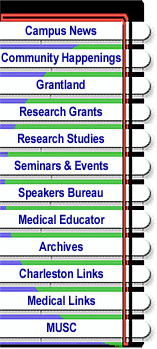


|
Prostate surgery device cuts risk of impotenceProstate cancer is the second leading cause of cancer death in men in this country and affects South Carolina men at a higher rate than the national average. But many men are reluctant to receive surgical treatment for fear of losing sexual function.A new device to help prostate surgeons avoid cutting the nerves near the prostate is now being used at MUSC along with several other major academic medical centers. Gerald W. Hull III, M.D., brought the technique to MUSC from the Memorial Sloan Kettering Cancer Institute in New York. A radical prostatectomy, or removal of a cancerous prostate gland, can be a lifesaving procedure, said Hull. But the accidental severing of the “erection nerves” near this gland during the procedure causes impotence. Fear of this complication has caused men to avoid seeking cancer screening tests and caused many to choose non-surgical treatments like radiation and watchful waiting. In recent years, surgeons have put a much greater emphasis on sparing the nerves, thus cutting the risk of impotence. This is particularly important, explained Hull, since the men who benefit from this surgery are usually younger, healthier men who have a significant life expectancy following surgery. Sexual function is an important part of their lives. The new technology, using a device called the CaverMap, refines the nerve-sparing surgery and may help reduce impotence rates after surgery. “The device allows us to better localize the nerve at the time of radical prostatectomy and improves the likelihood that the nerves will be spared,” said Hull. The nerves, which are no bigger than a human hair, transmit the signal that sparks an erection. They are entwined with blood vessels and tissue, and therefore are very difficult for the surgeon to see during the prostatectomy. Using the CaverMap during surgery, the surgeon points a slender wand with an electronic probe at the area where he suspects the nerve to be. If a nerve is correctly located, the current stimulates an erection and illuminates lights on a monitor screen. The surgeon can then work around that area. The technique hasn’t been used long enough to gain solid data on results. Early research on a small number of patients shows there has been an increase in potency with use of the device. “In one of the procedures I have performed with the mapping procedure at MUSC, the nerves were not at all visible, and I felt the device helped me avoid severing the nerves,” said Hull. He said that success is dependent on the age and erectile function of the patient prior to surgery. If they are young and have normal erectile function prior to surgery, 60 to 70 percent of the patients will have erections afterwards. “During the surgery, after removal of the prostate, we can use the nerve
stimulator to determine the likelihood that erectile function will return,”
said Hull. “If we get a good response using the CaverMap following surgery,
the prognosis will be good.” This is important because even when the nerves
are spared, erectile function usually does not return immediately. This
helps the surgeon inform the patient of his prognosis for return of his
erections following recovery.
|